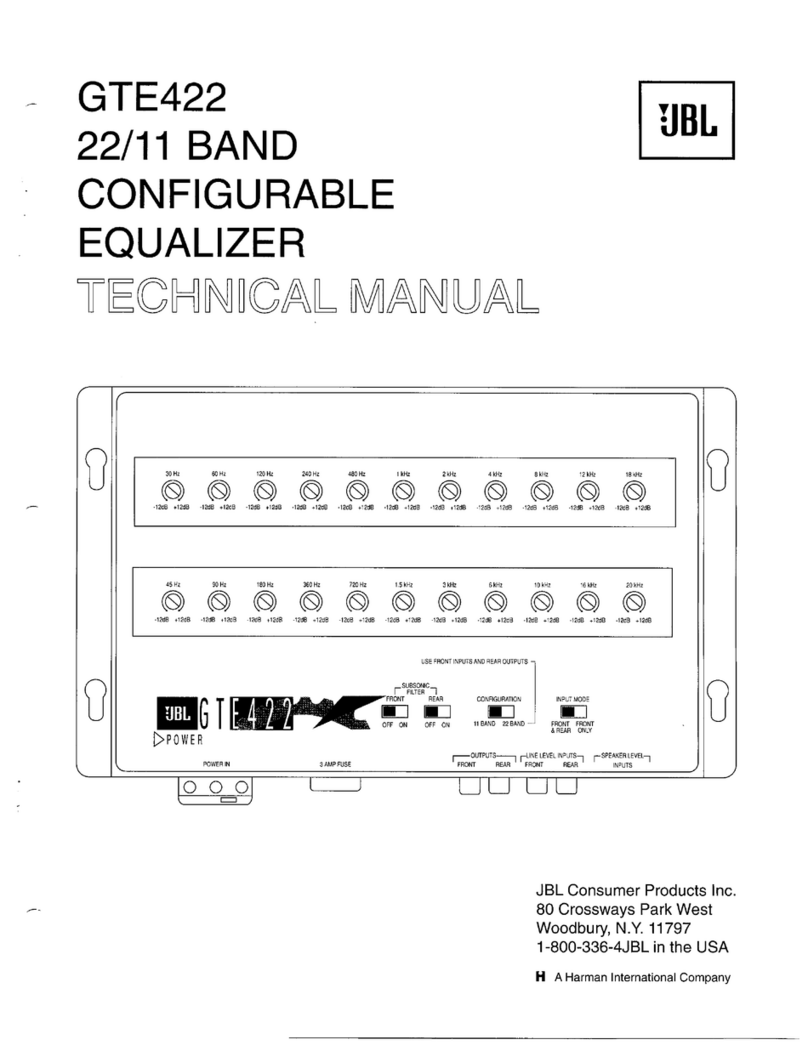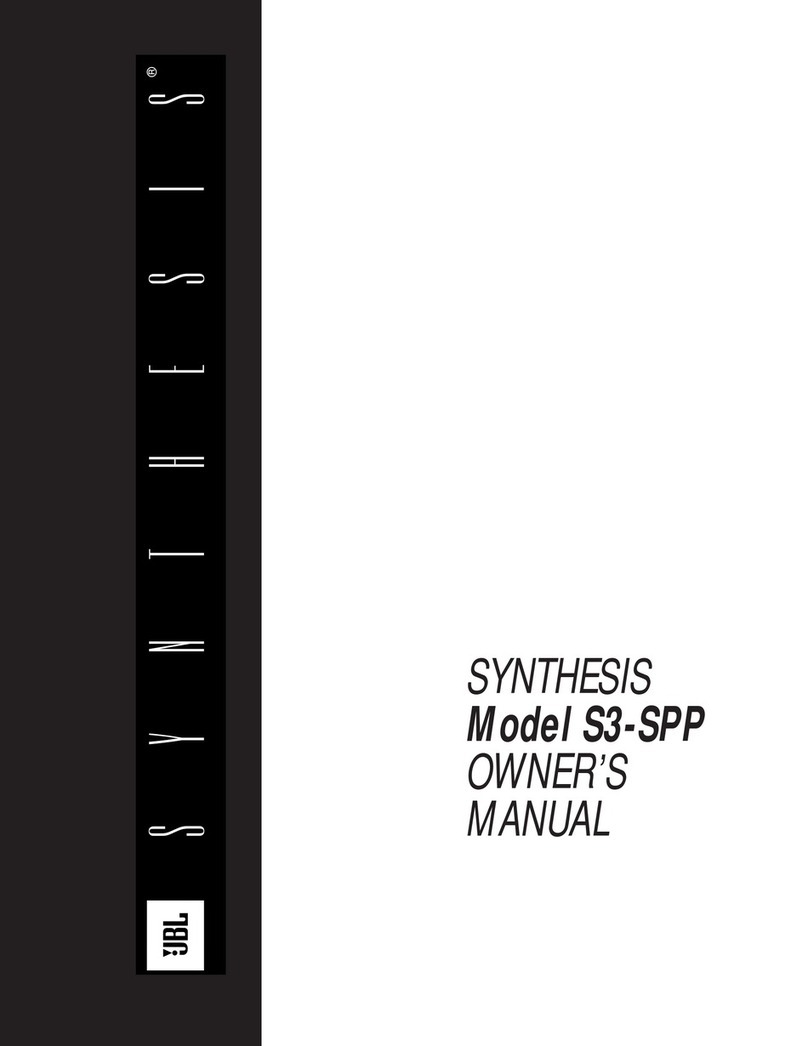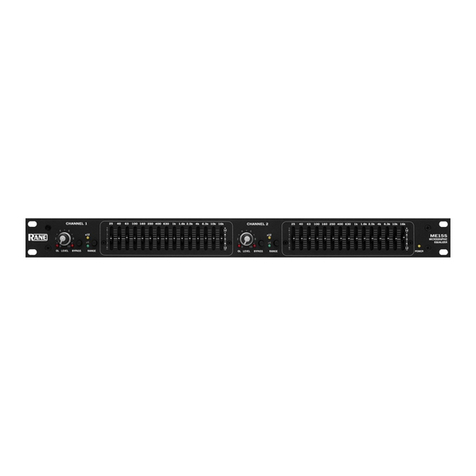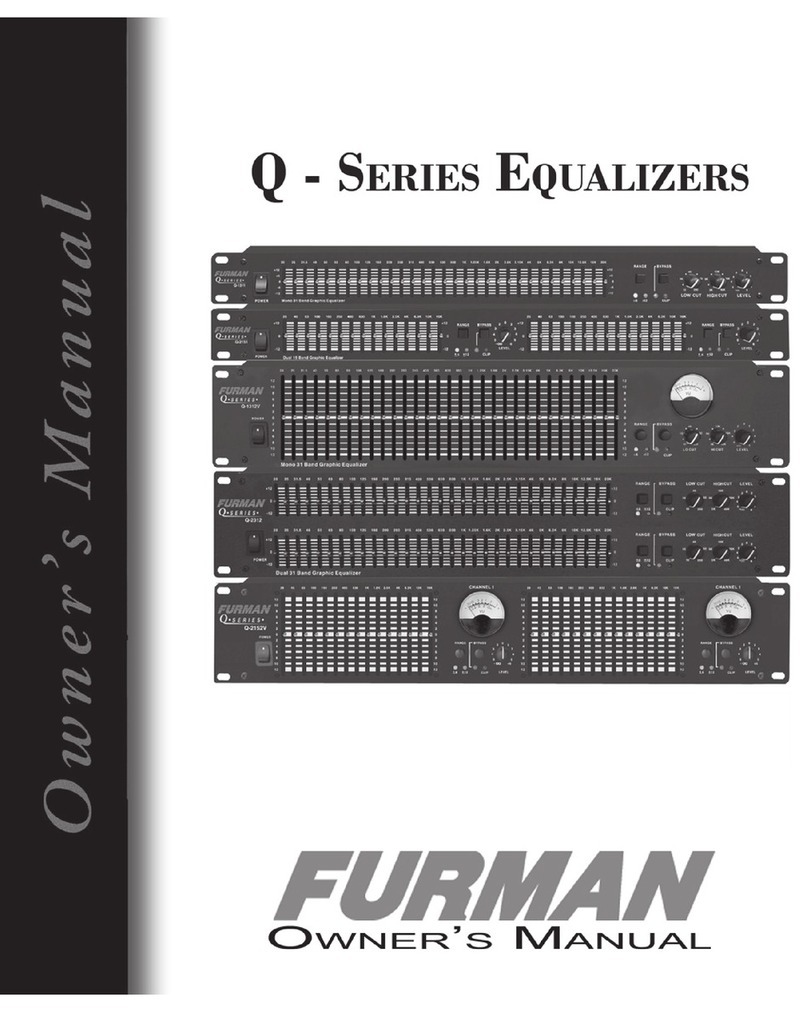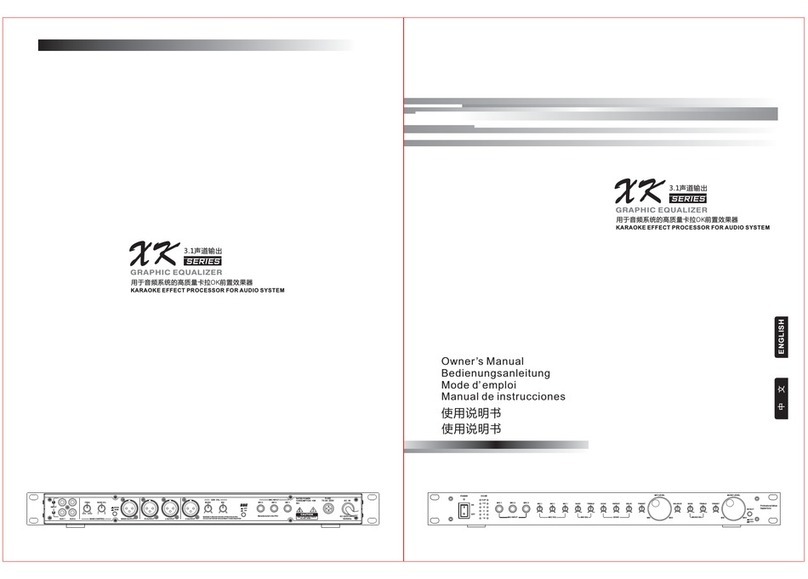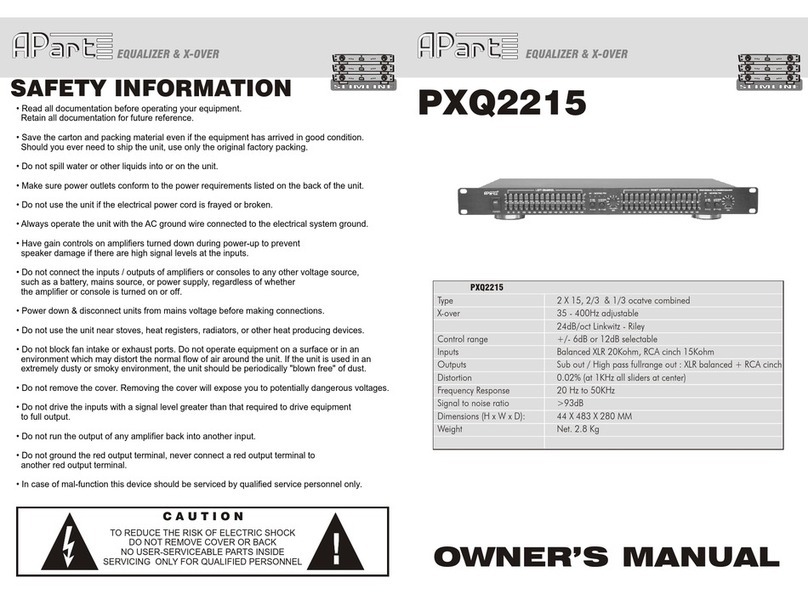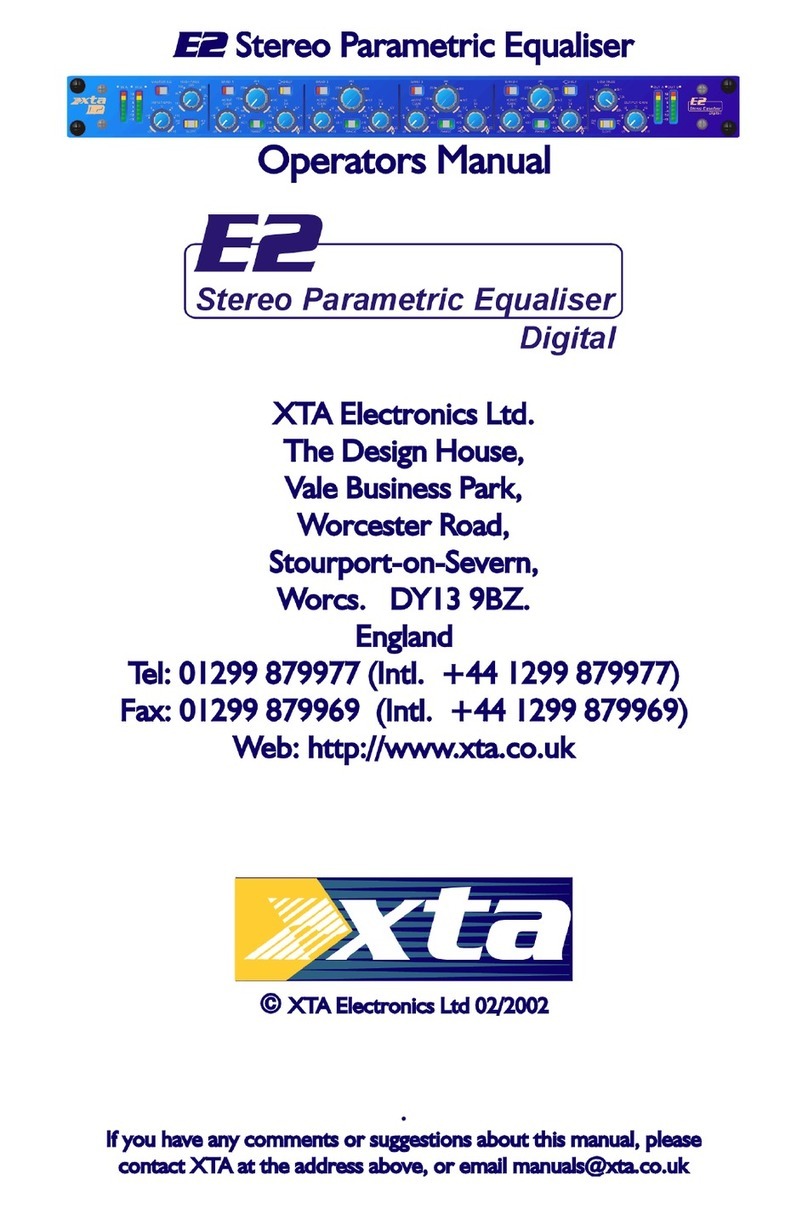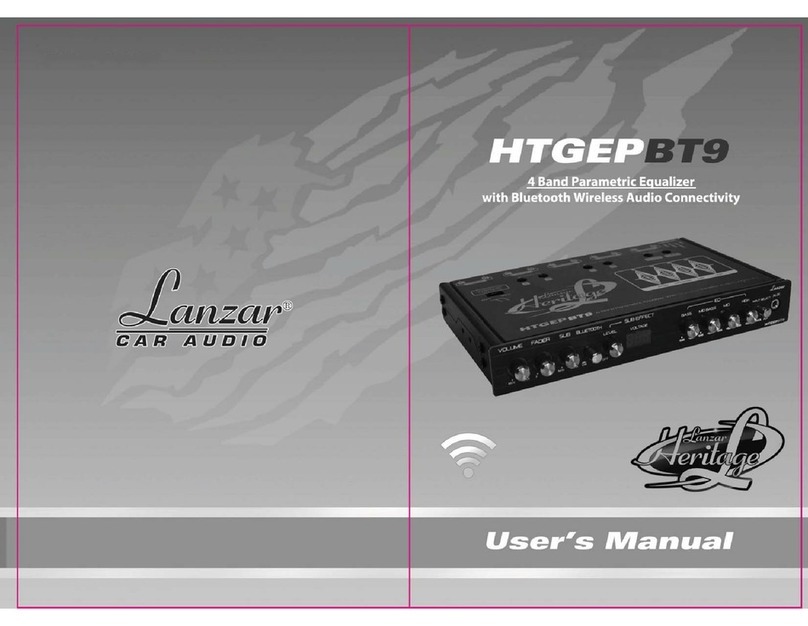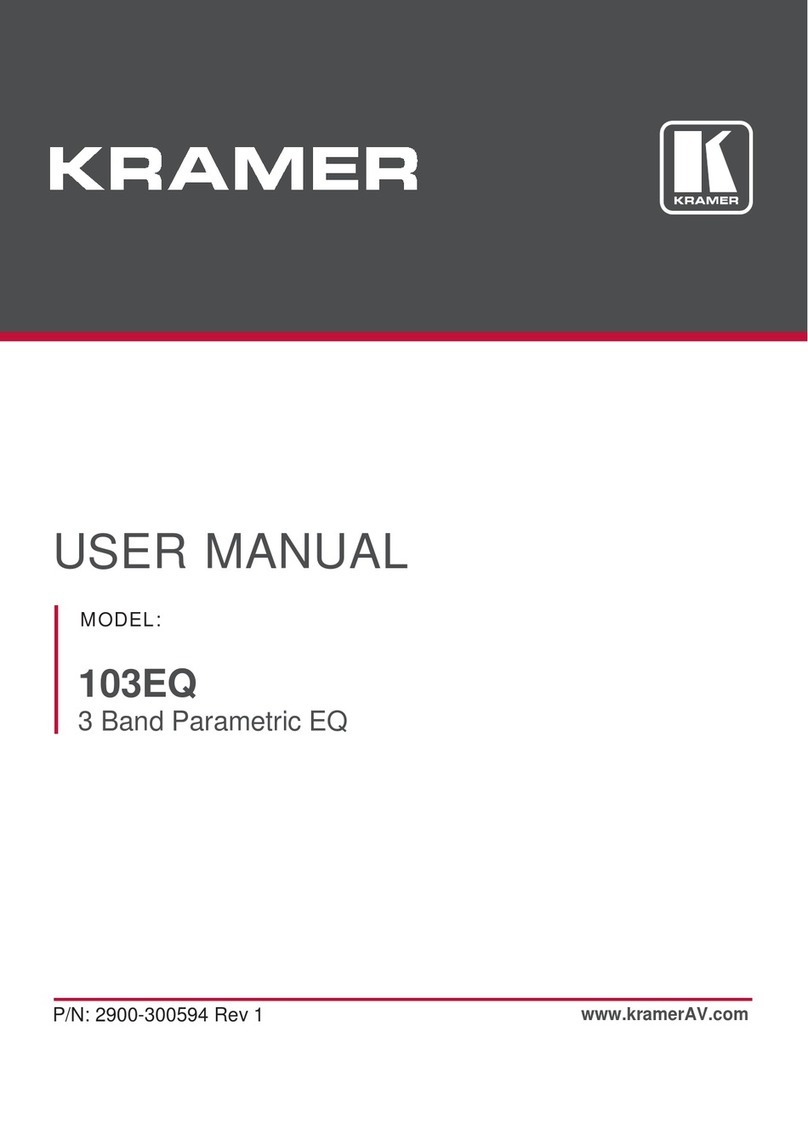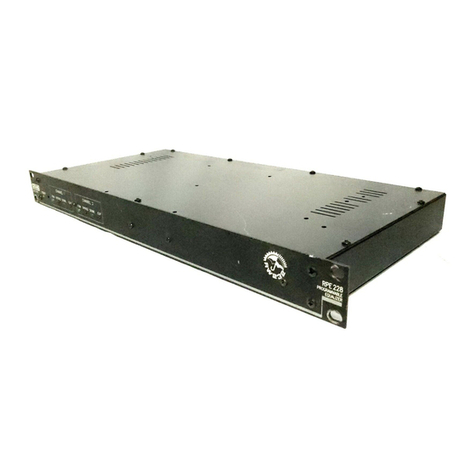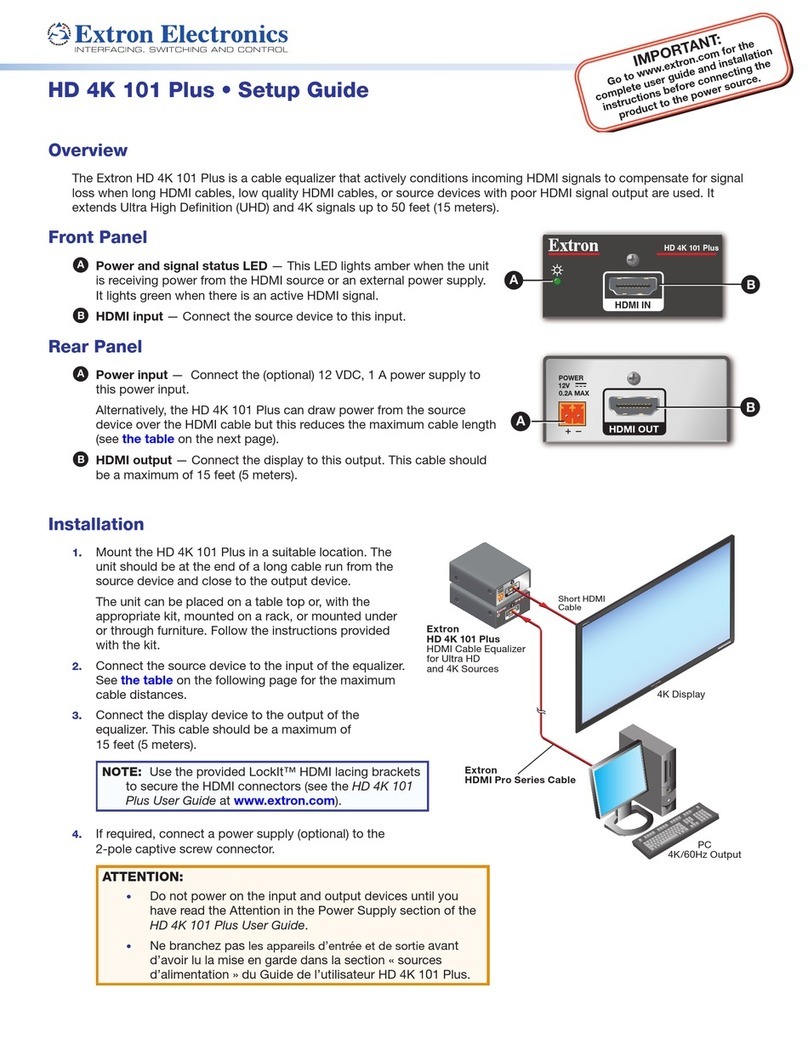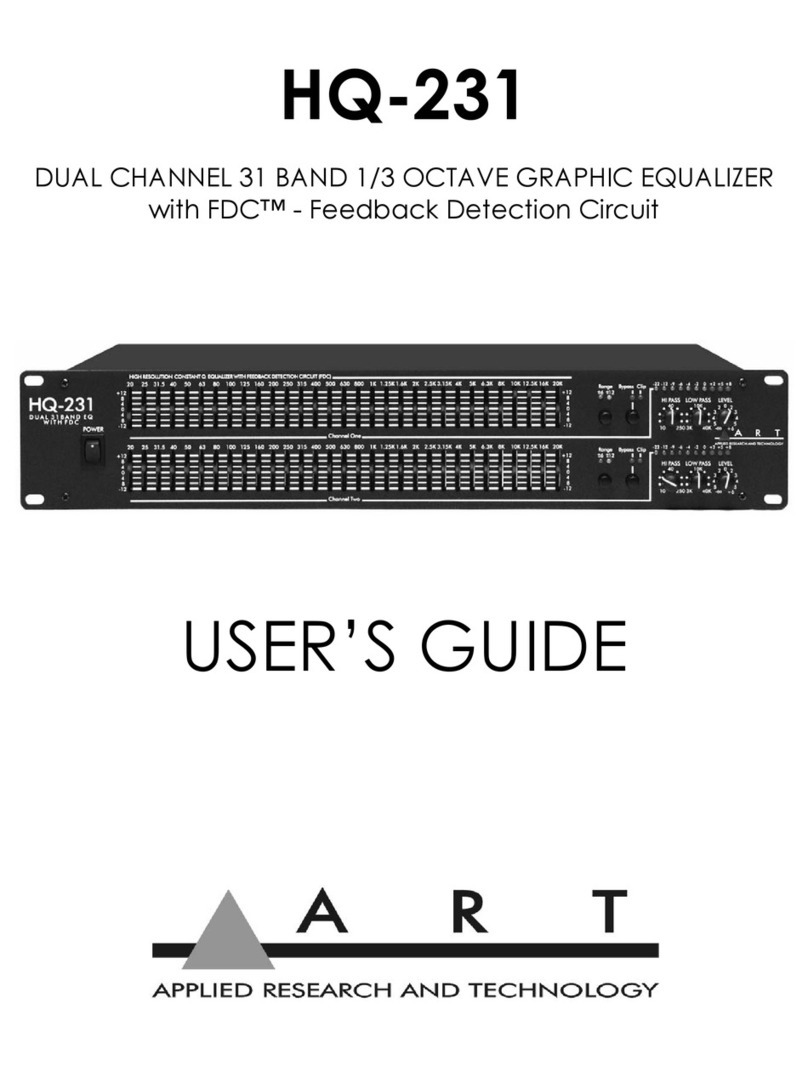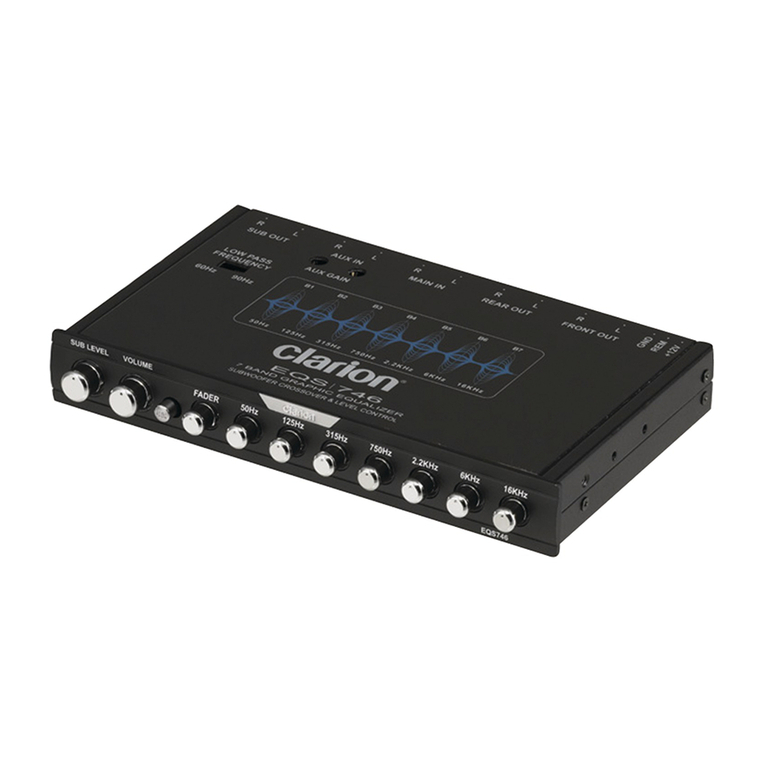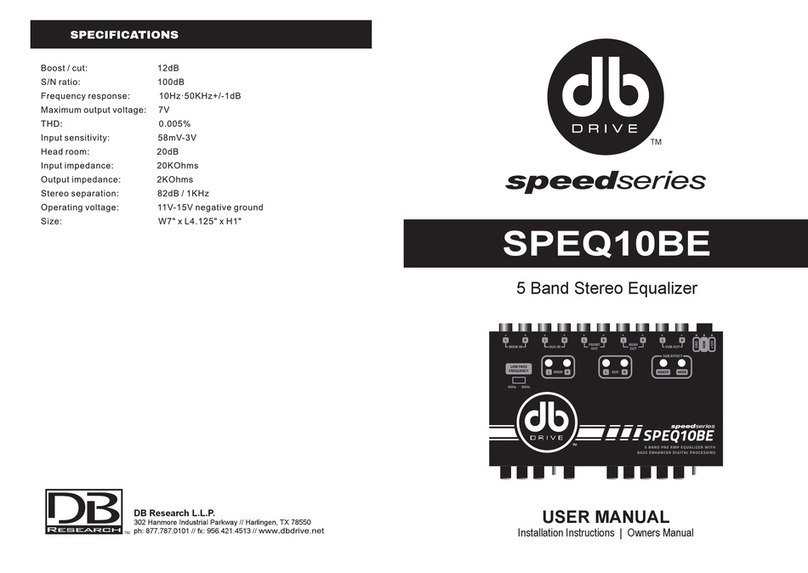JBL SYNTHESIS SDEC-1000 User manual

SYNTHESIS
SDEC-1000/2500
INSTALLATION
GUIDE


TABLE
OF
CONTENTS
SECTION ___________________________________________________________PAGE
1.0 _________________________________________________________PRECAUTIONS
5.5 Important Safeguards for Audio Products _________________________________________7–10
2.0_____________________________________________INTRODUCTION TO THE SDEC
2.0 Introduction __________________________________________________________________________11
The Concept __________________________________________________________________________11
2.1 SDEC-1000 and SDEC-2500 Rear Panels ____________________________________________________12
2.2 What the SDEC does_________________________________________________________________13–17
Driver EQ ____________________________________________________________________________13
Driver Time Correction __________________________________________________________________14
Channel-to-Channel Distance Correction (Auto-Time Correction)__________________________________15
Crossovers ___________________________________________________________________________15
Screen Correction______________________________________________________________________16
Modes_______________________________________________________________________________16
Room Correction EQ_________________________________________________________________16–17
3.0 __________________________________________________INSTALLING THE SDEC
3.1 Location, Location, Location . . .___________________________________________________________18
3.2 A Note On Wiring ______________________________________________________________________19
3.3 Wiring Connections to the SDEC________________________________________________________20–22
Case I – Replacing an analog equalizer in an existing Synthesis system _________________________20–21
Case II – Installing an SDEC as part of a new Synthesis system installation_______________________21–22
Power the system up for the first time ______________________________________________________22
4.0_______________________________THE DIGITAL ACOUSTIC CALIBRATION SYSTEM
4.1 Operational Overview ________________________________________________________________23–27
Stimulus _____________________________________________________________________________23
Data Acquisition ____________________________________________________________________23–24
Data Post-Processing___________________________________________________________________24
Display Data __________________________________________________________________________24
Make Corrections ______________________________________________________________________25
Target Curves ______________________________________________________________________25
Ideal Low-Frequency Response __________________________________________________25–26
Ideal High-Frequency Response__________________________________________________26–27
4.2 DACS4 Connections and Use __________________________________________________________28–32
Things To Consider When Selecting A Location For DACS4 ______________________________________28
Hookup ______________________________________________________________________________29
AC/Power Connections _______________________________________________________________29
Audio Connections __________________________________________________________________30
Other Connections __________________________________________________________________30
Microphone Connection and Placement _______________________________________________30–32
3

4
Room Placement ________________________________________________________________30
How is the Room Used?________________________________________________________31
Microphone #1 _______________________________________________________________31
Now Place the Remaining Microphones _________________________________________31–32
4.3 Power Up Synthesis and DACS4___________________________________________________________33
4.4 Preliminary Surround Processor Settings____________________________________________________34
I. Global Settings ______________________________________________________________________34
II. Mode Specific Settings________________________________________________________________34
4.5 DACS4 Operation ___________________________________________________________________35–40
Notational Conventions__________________________________________________________________35
About Online Help___________________________________________________________________35
[F-1] Help ______________________________________________________________________35
Starting DACS4________________________________________________________________________35
Initial DACS4 Screen_________________________________________________________________36
Enter Customer Information___________________________________________________________37
Synthesis Model____________________________________________________________________38
Select a Surround Processor __________________________________________________________38
Center Screen Compensation __________________________________________________________39
Left/Right Compensation _____________________________________________________________39
Confirm DACS4 Connections __________________________________________________________40
4.6 DACS4 Main Screen _________________________________________________________________41–45
Response Graph _______________________________________________________________________42
Filters at a Glance ______________________________________________________________________42
Individual Filter Control__________________________________________________________________43
Channel and Mode Selection/Status ________________________________________________________43
Overlay Previously Tested Channels ________________________________________________________44
Online Help___________________________________________________________________________44
Special Function Keys________________________________________________________________44–45
4.7 Calibration Walk-Through _____________________________________________________________46–56
Auto-Time Correction ___________________________________________________________________47
Cinema, Subwoofer Calibration_________________________________________________________48–50
Setting the Level ____________________________________________________________________49
Auto-Equalization ___________________________________________________________________50
Cinema, Left – Center – Right Calibration_________________________________________________48–50
Setting the Level____________________________________________________________________51
Run Auto-EQ_______________________________________________________________________52
Left and Right Ambient Calibration______________________________________________________52–53
Setting The Level ___________________________________________________________________53
Music Mode Calibration _________________________________________________________________53
TABLE
OF
CONTENTS
SECTION ___________________________________________________________PAGE

TABLE
OF
CONTENTS
SECTION ___________________________________________________________PAGE
Quitting DACS4________________________________________________________________________54
After A Complete Calibration __________________________________________________________54
Quitting When Some Channels Are Not Accepted___________________________________________54
SDEC Maintenance _____________________________________________________________________54
Using the Loader Utility ______________________________________________________________54
Troubleshooting ____________________________________________________________________55–56
Correcting Hum Problems ____________________________________________________________55
Why Does It Hum In The First Place?_________________________________________________55
What You Can Do During Installation _________________________________________________55
Video Devices___________________________________________________________________56
5.0 _______________________________________________________SPECIFICATIONS
5.0 Specifications _________________________________________________________________________57
6.0 ___________________________________________INTERCONNECTION DIAGRAMS
Synthesis One Interconnection Diagram _____________________________________________________58–59
Synthesis Two and Three Interconnection Diagram ____________________________________________60–61
7.0 ____________________________________________CONTROL WIRING DIAGRAMS
Synthesis One Control Wiring Diagram______________________________________________________62–63
Synthesis Two and Three Control Wiring Diagram _____________________________________________64–65
8.0__________________________________________SYNTHESIS LIMITED WARRANTY
6.0 Synthesis Limited Warranty ______________________________________________________________66
JBL Synthesis SDEC-1000/2500
Installation Guide
©1998 Harman Digital Systems Group
“Dolby” and “Pro Logic” are trademarks of Dolby Laboratories.
Confidential Unpublished Works. ©1992–1997
Dolby Laboratories, Inc. All Rights Reserved
THX is a registered trademark of Lucasfilm, Ltd.
JBL and Synthesis are registered trademarks of JBL Incorporated.
All Rights Reserved
Design and digital production by Harman Digital Systems Group
Design and Production Center, Woodbury, New York
JBL Consumer Products
250 Crossways Park Drive, Woodbury, NY 11797
8500 Balboa Boulevard, Northridge, CA 91329
800-336-4JBL
Printed on Recycled Paper
Part Number: 1113-SDECInstal
5

TABLE
OF
Figures
Figure 1: Raw Driver Response/Corrected Driver Response _________________________________________13
Figure 2: System With & Without Driver Time Correction___________________________________________14
Figure 3: Effect of Auto-Time Correction________________________________________________________15
Figure 4: Effect of Screen Correction EQ ________________________________________________________16
Figure 5: Effect of Room EQ _________________________________________________________________17
Figure 6: System Response In 5 Locations ______________________________________________________26
Figure 7: Synthesis 1 Main Target Curve, Below 1kHz______________________________________________28
Figure 8: Complete Synthesis 1 Target Curve ____________________________________________________29
Figure 9: DACS4 Connection to Synthesis_______________________________________________________31
Figure 10: Microphone Placement: Large Listening Area ____________________________________________33
Figure 11: DACS4 Opening Screen _____________________________________________________________37
Figure 12: Customer Information Window _______________________________________________________38
Figure 13: Customer Information Window: Select A Synthesis Model___________________________________39
Figure 14: Select A Surround Processor _________________________________________________________39
Figure 15: Identify Screen Type, Center Channel ___________________________________________________40
Figure 16: Identify Screen Type, Left & Right Front_________________________________________________40
Figure 17: DACS4 On Screen Wiring Diagram_____________________________________________________41
Figure 18: DACS4 Main Calibration Screen _______________________________________________________42
Figure 19: Response Graph Window____________________________________________________________43
Figure 20: Filter Setting and Control Field ________________________________________________________43
Figure 21: Filter Control Field _________________________________________________________________44
Figure 22: Direct Channel and Mode Access______________________________________________________44
Figure 23: Channel Display Control Field_________________________________________________________45
Figure 24: Continuously Updated Online Help_____________________________________________________45
Figure 25: Function Keys and Status Line ________________________________________________________45
Figure 26: Channel Gain and Delay Information ___________________________________________________46
Figure 27: Fresh Install, First Screen____________________________________________________________47
Figure 28: Auto-Time Correction Dialog Box______________________________________________________48
Figure 29: Ready For Subwoofer Level Test ______________________________________________________49
Figure 30: Setting Level______________________________________________________________________50
Figure 31: Without Smoothing Filter ____________________________________________________________50
Figure 32: Results of Auto-EQ_________________________________________________________________51
Figure 33: Left Cinema Level Set_______________________________________________________________52
Figure 34: Auto-EQ _________________________________________________________________________53
Figure 35: Ambient Target____________________________________________________________________54
6

The lightning flash with arrowhead
symbol, within an equilateral trian-
gle, is intended to alert the user to
the presence of uninsulated ”dan-
gerous voltage” within the product's
enclosure that may be of sufficient magnitude to
constitute a risk of electric shock to persons.
The exclamation point within an
equilateral triangle is intended to
alert the user to the presence of
important operating and mainte-
nance (servicing) instructions in
the literature accompanying the unit..
CAUTION
RISK OF ELECTRIC SHOCK
DO NOT OPEN
CAUTION: TO REDUCE THE RISK OF ELECTRIC SHOCK, DO NOT REMOVE COVER (OR BACK). NO
USER-SERVICEABLE PARTS INSIDE. REFER SERVICING TO QUALIFIED SERVICE PERSONAL.
WARNING: TO REDUCE THE RISK OF FIRE OR ELECTRIC SHOCK, DO NOT EXPOSE THIS UNIT
TO RAIN OR MOISTURE.
CAUTION: TO PREVENT ELECTRIC SHOCK, DO NOT USE THIS (POLAR-
IZED) PLUG WITH AN EXTENSION CORD RECEPTACLE OR OTHER OUT-
LET UNLESS THE BLADES CAN BE FULLY INSERTED TO PREVENT
BLADE EXPOSURE.
ATTENTION: POUR PREVENIR LES CHOCS ELECTRIQUES NE PAS
UTILISER AVEC UN PROLONGATEUR. UNE PRISE DE COURANT OU UNE
AUTRE SORTIE DE COURANT SAUF SI LES LAMES PEUVENT ETRE
INSEREES A FOND SANS EN LAISSER AUCUNE PARTIE A DECOUVERT.
1.1
IMPORTANT SAFEGUARDS
7
1.0
PRECAUTIONS
1.1 Important Safeguards
For Audio Products
PLEASE READ CAREFULLY ALL THE
FOLLOWING IMPORTANT SAFEGUARDS
THAT ARE APPLICABLE TO YOUR EQUIPMENT
1. Read Instructions – All the safety and operating
instructions should be read before the product
is operated.
2. Retain Instructions – The safety and operating
instructions should be retained for future reference.
3. Heed Warnings – All warnings on the product
and in the operating instructions should be
adhered to.
4. Follow Instructions – All operating and use
instructions should be followed.
5. Water and Moisture – The product should not
be used near water – for example, near a bathtub,
washbowl, kitchen sink, laundry tub, in a wet base-
ment, or near a swimming pool, and the like.
6. Carts and Stands – The product should be
used only if a cart or stand is recommended by
the manufacturer.
6a. A product and cart combination should be moved
with care. Quick stops, excessive force, and
uneven surfaces may cause the product and cart
combination to overturn.
7. Wall or Ceiling Mounting – The product
should be mounted on a wall or ceiling only when
and as recommended by the manufacturer.
8. Ventilation – The product should be situated
so that its location or position does not interfere
with its proper ventilation. For example, the prod-
uct should not be situated on a bed, sofa, rug, or
similar surface that may block the ventilation
openings; or placed in a built-in installation, such
as a bookcase or cabinet, that may impede the flow
of air through the ventilation openings.
9. Heat – The product should be situated away
from heat sources such as radiators, heat registers,
stoves, or other products that produce heat. If
placed near an amplifier, check with the
manufacturer for applicability.
10. Power Sources – The product should be
connected to a power supply only of the type
described in the operating instructions or as
marked on the product.
11. Grounding or Polarization – Precautions
should be taken so that the grounding or
polarization means of a product is not defeated.
12. Power-Cord Protection – Power-supply cords
should be routed so that they are not likely to be
walked on or pinched by items placed upon or
against them, paying particular attention to cords
at plugs, convenience receptacles, and the point
where they exit from the product.
13. Cleaning – The product should be cleaned only
as recommended by the manufacturer.
14. Power Lines – An outdoor antenna should be
located away from power lines.

8
ANTENNA
LEAD-IN
WIRE
ANTENNA
DISCHARGE UNIT
(NEC SECTION 810-20)
GROUNDING CONDUCTORS
(NEC SECTION 810-21)
GROUND CLAMPS
POWER SERVICE GROUNDING
ELECTRODE SYSTEM
(NEC ART 250, PART H)
Example of Antenna Grounding
as per National Electrical Code
1.1
IMPORTANT SAFEGUARDS
15. Nonuse Periods – The power cord of the prod-
uct should be unplugged from the outlet when left
unused for a long period of time.
16. Object and Liquid Entry – Care should be taken
so that the objects do not fall and liquids are not
spilled into the enclosure through the openings.
17. Outdoor Antenna Grounding – If an outside
antenna is connected to the receiver, be sure the
antenna system is grounded so as to provide some
protection against voltage surges and built-up
static charges. Article 810 of the National Electrical
Code, ANSI/NFPA 70, provides information with
regard to proper grounding of the mast and
supporting structure, grounding of the lead-in
wire to an antenna-discharge unit, size of ground-
ing conductors, location of antenna-discharge
unit, connection to grounding electrodes, and
requirements for the grounding electrode (see
above figure).
18. Damage Requiring Service – The
product should be serviced by qualified service
personnel when:
a. The power supply or the plug has been
damaged; or
b. Objects have fallen on, or liquid has been
spilled into, the product; or
c. The product has been exposed to rain; or
d. The product does not appear to operate
normally or exhibits a marked change in
performance; or
e. The product has been dropped, or the
enclosure damaged.
19. Servicing – The user should not attempt to ser-
vice the product beyond what is described in the
operating instructions. All other servicing should
be referred to qualified service personnel.
Note To CATV System Installer:
This reminder is provided to call the CATV system
installer’s attention to Article 820-22 of the NEC
that provides guidelines for proper grounding and,
in particular, specifies that the cable ground shall be
connected to the grounding system of the building,
as close to the point of cable entry as practical.

Français
Instructions de Sûreté Importantes
Gardex ces instructions pour réference future.
Observez toutes les instructions et tous les avertissements marqués sur l’appareil.
Branchez uniguements sur un réseau de tension indiquée. Consultez le manuel
d’instruction du fabriquant pour les spécifications de courant. N’oubliez pas que
différentes tensions peuvent nécessiter l’utilisation de cables et/ou de fiches
deconnexion différents.
N’installez pas l’appareil en un compartiment non-aéré ou directement au-dessus
d’équipements générateurs de chaleur, tels qu’amplificateurs de courants, etc. Ne
dépassez pas la température ambiante maximale de fonctionnement indiquée
dans les spécifications du produit.
Des fentes et ouvertures sont prévues dans le boîtier pour l’aération; Pour assurer
le bon fonctionnement et pour prévenir l’échauffement, ces ouvertures ne doivent
pas être couvertes ou bloquées. N’insérez pas d’objets dans les fentes d’aération.
Empêchez tout liquide de se répandre sur l’appareil.
Ce produit est muni d’une fiche à trois fils pour la mise à terreee. Ceci est une
mesure de sécurité et ne doit pas être contrariée.
Ne connectez jamais d’amplificateurs audio directement aux connecteurs de
l’appareil.
Pour empêcher les chocs électriques et le danger d’incendie, évitez d’exposer
l’appareil à la pluie ou à l’humidité, et ne le mettez pas en marche en un endroit
où il serait exposé aux éclaboussures d’eau.
N’essayez pas de faire fonctionner l’appareil s’il est tombé à terre, a été endom-
mangé, exposé à un liquide, ou si vous observez des différences nettes dans son
fonctionnement, indiquant la nécessité de réparations.
Cet appareil ne doit être ouvert que par un personnel de service qualifié. En enle-
vant les couvercles vous vous exposez àdes tensions électriques dangereuses.
Ce triangle, sur votre appaeil vous avertit de la présence de ten-
sion dangereuse, non-isolée à l’intérieur du boîtier…une tension
suffisante pour représenter un danger d’electrocution.
Ce triangle sur sur votre appareil vous invite de suivre d’impor-
tantes instructions d’utillisation et d’entretien dans la documenta-
tion livrée avec le produit.
Español
Instrucciones importantes de sequiridad
Guarde esta instrucciones para uso posterior.
Utilice siempre el voltaje correcto. Diríjase a las instrucciones de operación del
fabricante para obtener las especificaciones de potencia. Esté al tanto de que
voltajes de operación distintos requieren el uso de cable y/o enchufes distintos.
No instale esta unidad en un estante sin vntilación, ni tampoco directamente
encima de equipose que generen calor tales como amplificadores de potencia.
Fíjese en las temperaturas ambientales máximas de operación que se mencionan
en las especificaciones del producto.
Las aperturas y ranuras del chasis sirven para proveer la ventilación necesaria
para operar la unidad con sequridad y para prevenir sobrecalentamiento, y por lo
tanto no pueden ser obstruidas o cubiertas. No introcuzca objetos de ningún tip
a través de las ranuras de ventilación, y nunca deje caer ningún líquido sobre
la unidad.
Este producto está equipado con un enchufe de 3 clavijas con conexión a ierra.
Este es un elemento de seguridad que no debe ser eliminado.
Nunca conecte ningùn tipo de salida de amplificadores de sonido directamente a
los conectores de la unidad.
Para prevenir descargas eléctricas o incendios, mantenga la unidad alejada de la
lluvia, humedad o cualquier lugar en el que pueda entrar en contacto con ague.
No trate de hacer funcionar la unidad si se ha caído, está dañada, ha entrado en
contacto con lítuidos, o si nota cualquir cambio brusco en su funcionamiento
que indique la necesidad de hacerle un servicio de mantenimiento.
Esta unidad deberá ser abierta únicamente por personal calificado. Si usted quita
las coberturas se expondrá a voltajes peligrosos.
Este triángulo que apaece en su componente le advierte sobre
la existencia dentro del chasis de voltajes peligrosos sin
aislantes…voltajes que son lo suficientemente grandes como
para causar electrocución.
Este triángulo que aparece en su componente lo alerta sobre las
instrucciones de operación y mantenimiento importantes que
están en los materiales de lectura que se incluyen.
Italiano
Importanti norme di sicurezza
Conservare le presenti norme per l’utilizzo futuro.
Osservare tutte le istruzioni e le avvertenze apposte sull’unita.
Utilizzare esclusivamente con la tensione di rete corretta. Consultare le istruzioni
operative fornite dal fabbricante per i dati riguardanti la tensione e l’assorbimento
di corrente. Potrebbe essere necessario l’uso di cavi di rete e/o di spine diverse a
seconda della tensione utilizzata.
Non installare l’unità in uno scaffale privo di ventilazione oppure direttamente
sopra una fonte di calore, come, ad esempio, un amplificatore. Non superare la
temperatura ambientale massima di funzionamento riportata nei dati tecnici del
prodotto.
Le fessure e le altre aperture nella scatola servono alla ventilazione. Per un fun-
zionamento affidabile, e per evitare un eventuale surriscaldamento, queste aper-
ture non vanno ostruite o coperte in nessun modo. Evitare in tutti i casi di inserire
oggetti di qualsiasi genere attraverso le fessure di ventilazione. Non versare mai
del liquido di nessun tipo sull’unità.
Questo pordotto viene fornito con una spina a 3 fili con massa. Tale dispositivo di
sicurezza non va leiminato.
Evitare sempre di collegare le uscite dell’amplificatore auio direttamente ai connet-
tori dell’unità.
Per prevenire il pericolo di folgorazione e di incendio non esporre l’unità alla
pioggia o ad un’umidtà eccessiva; evitare di adoperare l’unità dove potrebbe
entrare in contatto con acqua.
Evitare di adoperare l’unità se la stessa è stata urtata violentemente, se ha subito
un danno, se è stata esposta ad un liquido o in caso di un evidente cambiamento
dell prestazioni che indichi la necessità di un intervento di assistenza tecnica.
Ogni intervnto sull’unità va esqguito esclusivamente da personale qualificato. La
rimozione della copertura comporta l’esposizione al pericolo di folgorazione.
ll present triangolo impresso sul componente avverte della
presenza di tensioni pericolose non isolate all’interno della
copertura…tali tensioni rappresentano un pericolo di folgorazione
ll presente triangolo imprsso sul componente avverte l’utente della
presenza nella documentazione allegata di importanti istruzioni
relative al funzionament ed alla manutenzione.
Deutsch
Wichtige Sicherheitsanweisungen
Heben Sie sich diese Sicherheitsanweisungen auch für später auf.
Befolgen Sie alle auf der Vorrichtung stehenden Anweisungen und Warnungen.
Immer nur mit der richtigen Spannung verwenden! Die Gebrauchsanweisungen
des Herstellers informieren Sie über die elektrischen Anforderungen. Vergessen
Sie nicht daß bei vershiedenen Betrievsspannungen ggf. auch verschiedene
Leitungskabel und/oder Verbindungsstacker zu verwenden sind.
Stellen Sie die Vorrightung nicht in ein unbelüftetes Getell oder unmittelbar
über wärmeerzeugende Geräte wie z.B. Tonverstärker. Halten Sie die in den
Produktspezifikationen angegebene maximale Umgebungstemperatur bei
Betrieb ein.
Schlitze und Öffnungen im GehUause dienen der Belüfung; um verläßlichen
Betrieb sicherzustellen und Überheizen zu vermeiden dürfen diese Öffnungen
nich verstopft oder abgedeckt werden. Stecken Sie nie irgend einen Gegenstand
durch die Belüftungsschlitze. Vergießen Sie keine Flüssigkeiten auf den Apparat.
Dieses Produkt is mit einem 3-drahtigen Erdungsstecher ausgerüstet. Diese
Sicherheitsmaßnahme darf nicht unwirksam gemacht werden.
Schließen Sie nie Tonverstärker unmittelbar an einen Anschluß des
Apparates an.
Um elektrischen Schlag oder Feuer zu vermeiden, setaen Sie den Apparat
weder Regen noch Feuchtigkeit aus und betreiben Sie ihn nicht dort wo Wasser
eindringen könnte.
Versuchen Sie nicht den Apparat zu betreiben falls er fallen gelassen, beschädigt,
oder Flüssigkeiten ausgesetzt wurde, oder falls sich seine Arbeitsweise derart
ändert daß daraus ein Bedarf nach Raparatur zu schließen ist.
Dieser Apparat sollte nur von qualifizierten Fachleuten geöffnet
werden. Das Abnehmen von Abdeckungen setzt Sie
gefährlichen Spannungen aus.
Dieses Dreick auf ihrem Apparat warnt Sie voe nicht-isolierter,
gefährlicher Spannung im Gehäuse…stark genug um eine
Berührungsgefahr darzustellen.
Diese Dreick auf ihram Apparat bedeutet daß wichtige Betriebs-
und Wartungsanweisungen in der mitgelieferten Dokumentation
zu finden sind.

Dansk
Vigtig information om sikkerhed
Gem denne vejledning til senere brug.
Følg all anvisninger og advaresler på apparatet.
Apparatet skal altid tilslttes den korrekte spænding. Der henvises til brugsanvis-
ningen, der indeholder specifikationer for strømforsyning. Der gøres opmærksom
på, at ved varierende driftsspændinger kan det blive nødvendigt at bruge andre
lednings- og/eller stiktyper.
Apparated må ikke monteres i et kabinet uden ventilation eller lige over andet
udstyr, der udvikler varme, f.eks. forstærkere. Den maksimale omgivelsestemper-
atur ved drift, der står opført i specifikationerne, skal overholdes.
Der er ventilationsåbninger i kainettet. For at sikre apparatets drift og hindre
overophidning må disse åbninger ikke blokeres elle tildækkes. Stik aldrig noget
ind igennem ventilationsåbningerne, og pas på aldrig at spilde nogen form for
væske på apparatet.
Dette apparat er forsynet med et stik med jordforbindelse. Denne sikkerheds-
foranstaltning må aldrig omgås.
Udgangsstik fra audioforstærkere må aldrig sættes direkte i apparartet.
Apparatet må ikke udsættes for regn eller fugt og må ikke bruges i nærheden af
vand for at undgå risiko for elektrisk stød og brand.
Apparatet må aldrig bruges, hvis det er blevet stødt, beskadiget eller vadt, eller
hvis ændringer i ydelsen typer på, at det trænger til eftersyn.
Fette apparat må kun åbnes af fagfolk, Hvis dækslet tages af, udsættes man for
livsfarlig højspænding.
Denne mærkat på komponenten advarer om uisoleret, farlig
spænding i apparatet… høj nok til at give elektrisk stød.
Denne mærkat på komponenten advarer om vigtig driftsog
vedligeholdsinformation i den tilhørende litteratur.
Suomi
Tärkeitä varten
Säilytä nämä ohjeet tulevaa käyttoöä varten.
Seuraa kaikkia yksikköön merkittyjä ohjeita ja varoituksia.
Käytä aina oikeaa verkkojännitettä. Tehovaatimukset selviävät valmista-
jan käyttöohjjeista. Huomaa, että eri käyttöjännitteet saattavat vaatia
toisenlaisen verkkojohdon ja/tai- pistokkeen käytön.
Älä asenna yksikköä telineeseen jossa ei ole tuulet usta, tai välittömästi
lämpöä tuottavien laitteiden, esim. tehovahvistimien, yläpuolelle.
Ympäristön Iämpötila käytössä ei saa ylittää twotespesifikaation
maksimilämpötilaa.
Kotelo on varustettu tuuletusreiillä ja -aukiooa. Luotettavan toiminnan
varmistamisksi ja ylilämiseksi näitä aukkoja ei saa sulkea tai peittää.
Mitään esineitä ei saa työntää tuuletusaukkoihin. Mitään nestritä ei saa
kaataa yksikköön.
Tuote on varustettu 3-jjohtimisella maadoitetulla verkkipistokkeella.
Tämä on turvallisuustoiminne eikä sitä saa poistaa.
Älä kytke audiotehovahvistimen lähtöjä suoraan mihinkään yksikön
liittimeen.
Sähköiskun ja palovaaran välttämiseksi yksikkö ei saa olla sateessa tai
kosteassa, eikä sitä saa käyttää märässä ympäristössa.
Älä käytä yksikköä jos se on pudonnut, vaurioitunut, kostunut, tai jos
sen suorituskkyky on huomattavasti muuttunut, maikä vaatii huoltoa.
Yksikön saa avata vain laitteeseen perehtynyt huoltohenkilö. Kansien
poisto altistaa sinut vaarallisille jännittelille.
Tämä kolmio, joka esiintyy homponentissasi, varoittaa
siua eristämättömän vaarallisen jännitteen esiintymisestä
yksikön sisällä. Tämä jännite saattaa olla riittävä korkea
aiheuttamaan sähköiskuvaaran.
Tämä koimio, joka esiintyy komponentissasi, kertoo sin-
ulle, että tässä tuotedokumentoinnissa esiintyy tärkeitä
käyttö-ja ylläpite-ohjeita.
Norsk
Viktig informasjon om sikkerhet
Ta vare pådenne veiledningen for senere bruk.
Følg alle anvisningene og advarslene som er angitt på apparatet.
Apparatet skal alltid anvendes med korrekt spenning.
Produktbeskrivelsen inneholder spesifikasjoner for strømkraav. Vær oppmerksom
på at det ved ulike driftsspenninger kan være nødvendig å bruke en annen
ledningog/eller støpseltype.
Apparatet skai ikke monteres i skap uten ventilasjon, eller direkte over varmepro-
duserende utstyr, som for eksempel kraftforsterkere. Den maksimale romtempera-
turen som står oppgitt i produktbeskrivelsen, skal overholdes.
Apparatet er utstyrt med ventilasjonsåpninger. For at apparatet skal være pålitelig
i bruk og ikke overopphetes, må disse åpningene ikke blikkeres eller tildekkes.
Stikk aldri noe inn i ventilasjonsåpningene, og pass på at det aldri søles noen
form for væske på apparatet.
Dette apparatet er utstyrt med et jordet støpsel. Dette er en sikkerhetsforanstalt-
ning som ikke må forandres.
Utgangsplugger fra audioforsterkere skai aldri koples direkte til apparatet.
Unngå brannfare og elektrisk støt ved å sørge for at apparatet ikke utsettes for
regn eller fuktighet og ikke anvendes i næheten an vann.
Apparatet skal ikke brukes hvis det har blitt utsatt for støt, er skadet eller blitt vått,
eller hvis endringer i ytelsen tyder på at det trenger service.
Dette apparatet skal kun åpnes av fagfolk. Hvis dekselet fjernes, utsettes man for
livsfarlig høyspenning.
Komponenten er merket med denne trekanten, som er en
advarsel om at det finnes uisolert, farlig spenning inne i kabinet-
tet…høy nok til å utgjøre en fare for elektrisk støt.
Komponenten er merket med denne trkanten, som betyr at den
tilhørende litteraturen inneholder viktige opplysninger om drift
og vedikehold.
Svenska
Viktiga säkerhetsföreskrifter
Spara dess föreskrifter för framtida bruk.
Följ alla anvisningar och varningar som anges på engeten.
Använd alltid rätt nätspänning. Se tillverkarens bruksanvisningar för informa-
tion om effektkrav. Märkväl, att andra matningsspänningar eventuellt kräver att
en annan typs nätsladd och/eller kontakt anänds.
Installera inte enheten i ett oventilerat stativ, eller direkt ovanför utrustningar
som avger värme, t ex effektförstärkare. Se till att omgivningens temperatur vid
drift inte överskrider det angivna värdet i produktspecifikationen.
Behållaren är försedd med hål och öppningar för ventilering. För att garantera
tillförlitlig funktion och förhindra överhettning får dessa oppningar inte block-
eras eller täckas. Inga föremål får skuffas in genom ventilationshålen. Inga
vätskor får spillas på enheten.
Produkten är försedd med en jordad 3-trådskontakt. Detta ä en säkerhetsfunk-
tion som inte får tas ur bruk.
Anslut aldrig audioeffektförstärkarutgångar direkt till någon av enhetens
kontakter.
För att undvika elstöt eller brandfara får eenheten inte utsättas för reegn eller
fukt, eller användas på ställen där den blir våt.
Använd inte enheten om den far fallit i golbet, skadats, blivit våt, eller om dess
prestanda förändrats märkbart, vilket kräver service.
Enheten får öppnas endast av behörig servicepersonal. Farliga spänningar blir
tillgängliga när locken tas bort.
Denna triangel, som visas på din komponent, varnar dig om en
oisolerad farlig spänning inne i engeten. Denna spänning är
eventuellt så hög att fara för elstöt föreligger.
Denna triangel, som visas på din komponent, anger att viktiga
bruksanvisningar och servideanvisningar ingår i dokumenta-
tionen i fråga.
10

JBL Synthesis SDEC-1000/ SDEC-2500 Installation Guide:
The SDEC-1000/2500 is a dealer installed digital equalizer and time correction unit. It is part of the Synthesis home
theater package. This Installation Guide will supply all the necessary information for the operation of the SDEC-1000 with
Synthesis 1, or the SDEC-2500 with Synthesis 2 and 3.
Introduction:
From its inception, JBL Synthesis has been the answer to the questions: “How do you build a state-of-the-art home theater
system and make it sound superb in every installation? How can you be sure all the hardware is compatible?” These were the
big questions five years ago – Synthesis was the answer.
Once again, JBL Synthesis moves beyond the competition and is the answer. The JBL Synthesis Digital Equalizer (SDEC)
is a six channel in/seven channel out 20-bit digital audio signal processor. Unlike nearly all other audio components on
the market, the SDEC has been designed to work specifically with other Synthesis System components. This narrow
application focus has allowed our engineers to design a product with far fewer compromises, resulting in unequalled
system performance. By reading the following pages, you will become familiar with the technological features and unique
capabilities incorporated within the SDEC and available nowhere else.
The Concept:
Visualize a speaker system with the highest performance components available. Imagine that you have the power of 20-bit
digital signal processing available to correct any remaining system non-linearity. Fantasize about crossovers that are
theoretically perfect, and time-domain correction delivering idealized impulse response.
The fun doesn’t stop there. Now that this perfected speaker is in the room, you’ve got arrival time correction, multipositional
spatially averaged measurements and scientifically derived target response curves for each speaker, multiband parametric
equalizers, auto-EQ algorithms and compensation for perforated video projection screens! How good would all this be? In a
few words, “very, very good”!
Okay, stop dreaming. It’s here, now. (It’s in that box over there, and you’re going to install it and make someone very
happy!) The JBL Synthesis Solution™. The SDEC and the Digital Acoustic Calibration System (DACS) together can
achieve what others only dream about.
Properly used, a high-quality equalizer can improve the overall sound quality of most systems. However, there are many
areas of a speaker’s behavior that can be improved, but only if you know, in advance, what the speaker needs. The
Synthesis solution allows this to be a reality. Until now, anything beyond the most basic equalization has been impossible
without expensive acoustical instrumentation and the knowledge to use it. This is why, traditionally, equalizers have been
general-purpose devices, designed to be applicable to any audio system, usually of doing more harm than good!
Add to this situation the fact that equalizing a speaker system by ear is truly a futile exercise. This helps to account for the
generally low acceptance of equalizers outside of professional audio applications.
11
2.0
INTRODUCTION
2.0
INTRODUCTION

2.1
SDEC-1000 REAR PANEL
SDEC-2500 REAR PANEL
System connection after dealer
installation and calibration.
12
SDEC-1000 Rear Panel
SDEC-2500 Rear Panel

2.2
WHAT THE SDEC DOES
13
The SDEC, available in two models that differ only slightly in function, is a digital signal processor capable of performing
several functions simultaneously. In general, the device is fed signals from the surround processor (the Synthesis SDP-1,
2 or 2D) that have been separated into discrete left, center, and right front channels, side and/or rear surround signals,
and subwoofer/lfe (low-frequency effects) signals.
By converting these six signals into digital bitstreams, and feeding them into a DSP (digital signal processing) engine
using extremely powerful Motorola processors, the signals can be manipulated in the digital domain to achieve several
desired results.
Driver correction, arrival time manipulation, room correction, and frequency division are some of the tricks easily done by
what amounts to a powerful, special-purpose computer, but which would require inordinate complexity (and would result
in signal-quality degradation) if done in the analog domain. After processing, high-quality digital-to-analog converters
return the signals to the analog domain, and pass them on to Synthesis amplifiers.
What the SDEC does:
Driver EQ:
The drivers used in Synthesis systems are designed and manufactured to reproduce both music and the audio associated
with cinema as faithfully as possible. But real-world mechanisms, however well crafted, have limitations imposed on their
operation due to the nature of available materials and the inescapable laws of physics. Because the SDEC is used only in
Synthesis systems and, therefore, is only used with a small number of different drivers, programs can be loaded into it to
smooth out response irregularities, compensate for manufacturing tolerances, etc. Tell the system during installation
whether it’s a Synthesis I, II, or III and corrections, programmed at the factory by JBL engineers, are instantly applied to
make very good drivers sound even better.
Figure 1:
Raw Driver Response/Corrected Driver Response

2.2
WHAT THE SDEC DOES
14
Driver Time Correction:
Once again, because the SDEC “knows” what speakers it’s being used with, it can correct for the different arrival times of
sounds from low- and high-frequency drivers. Arrival times are slightly different because the horns, tweeters, and
midrange drivers are mounted at somewhat different distances from the listener. The SDEC can delay the sound coming
from the closer drivers slightly, so that all frequencies impinge on the listener’s ears simultaneously, reducing acoustic
“smear”. All the frequency components that comprise complex waveforms arrive together; the end result is greater fidelity
to the original waveshape.
Figure 2:
System With and Without Driver Time Correction

2.2
WHAT THE SDEC DOES
15
Channel to Channel Distance Correction (Auto-Time Correction):
The listener’s preferred listening location doesn’t always coincide with the “acoustically best” position; furniture place-
ment, screen location, traffic patterns and other factors can keep us from sitting where “sound sounds best”, typically
determined by speaker placement geometry. The SDEC can compensate for unequal distances to loudspeakers and move
the “sweet spot” to the listener. This feature is called “Auto-time arrival correction” in the Synthesis system.
Figure 3:
Effect of Auto-Time Correction
Crossovers:
The SDEC-1000 (used in bi-amplified Synthesis I systems) performs the function of electronic crossover in addition to its
other tasks. This allows for more precise transducer correction and all other attendant advantages of bi-amplification. The
crossovers are 24dB per octave (4th order) Linkwitz-Riley type. This high-performance class of filter is rarely attempted in
passive crossover designs due to its inherent complexity.

2.2
WHAT THE SDEC DOES
16
Screen Correction:
The computational power of the SDEC allows it to compensate for the effects of placing the front center channel
loudspeaker behind any of several popular types of projection perforated screen material.
Figure 4:
Effect of Screen Correction EQ
Modes:
Although not a major consideration before the advent of home theater, inherent differences exist between an
idealized music-only and an idealized cinema sound reproduction system. Cinema sound is produced with using
theater speakers that employ horn-loaded compression drivers. The directivity-index of horn-loaded drivers is signifi-
cantly different from that of direct radiator designs. The best way to reproduce cinema audio is with speakers that exhibit
similar directivity characteristics.
Synthesis systems employ horn-loaded drivers for cinema and direct radiators for music.
The SDEC contains two sets of equalization curves selected by the system controller for each of the Synthesis I, II, and III
systems. Sources identified by the SDP-2 or the more recent DTS-equipped SDP-2D as music-only are fed through con-
ventional midrange cone drivers and dome tweeters; theatrical audio is automatically fed to horn-based transducers, and
equalization is changed to the appropriate settings.
Room Correction EQ:
The parameter (or, more accurately, set of parameters) more responsible for overall sound quality than almost any other is
the acoustic signature, or characteristics, of the listening environment. Absolute room dimensions, the ratio of the room
dimensions, the shape of the room, absorption/reflection characteristics of the walls, and room furnishings can make
the most expensive equipment sound mediocre or enhance the sound of mediocre equipment. In this area, the SDEC is

2.2
WHAT THE SDEC DOES
17
nothing less than magic! With 90 available bands of parametric equalization (each adjustable for center frequency,
amount of boost or cut, and bandwidth (the reciprocal of Q), its ability to address the specific problems of a given envi-
ronment is far beyond any graphic equalizer. Typically, such devices are two-edged swords, able to cause at least as many
problems as they solve. In this case, however, a preprogrammed computer, using proprietary algorithms developed over a
period of several years by JBL, guides the automatic adjustment process, transforming acoustic torture chambers into
acoustically superior environments. The essential ingredient necessary for success is knowledge of what can and cannot
be corrected with equalization.
Figure 5:
Effect of Room EQ

3.1
LOCATION, LOCATION, LOCATION ... 3.0
INSTALLING THE SDEC
18
Location, location, location…
(Please note that this installation guide assumes a U.S. location, in which the power source is 120 volt, 60Hz. JBL can
supply the SDEC for use in 230 volt, 50Hz environments on special order. Contact JBL for details and delivery information.)
Pick a location, determined by the relationship to other equipment and power availability. Note that there are NO user
controls on the SDEC: it need NOT be located where the user can easily reach it. Once programmed, it is turned On AND
Off by trigger signals from the Synthesis SDP-1, 2 or 2D, and, in turn, triggers the power amplifiers on and off. It can be
located close to the surround processor/decoder or close to the power amplifiers, although it should NOT be subject to
the heat they generate. For this reason, it may be better to locate it near the surround processor.
To simplify the following discussion, it will be assumed that the surround processor/decoder is a Synthesis SDP-2D,
although it may be an earlier SDP-1 or SDP-2. The SDP-1 is a Dolby®Pro Logic®decoder and control system, while
the SDP-2 incorporates the ability to decode AC-3®signals from DVD players or laser disc players equipped with RF
demodulators, such as the Synthesis SDP-RFD. The SDP-2D, the newest addition to the Synthesis family of controller/
processors, adds DTS decoding capability, while retaining AC-3 and Pro-Logic modes of operation. In subsequent
discussion, the word “controller” will be used to indicate the SDP-1, 2 or 2D, or whatever alternate equipment is being
used to select input sources and control power to ”downstream” pieces of signal processing equipment.
Frequently, the SDEC will be retrofitted to a Synthesis system previously equipped with an analog equalizer. It can
be mounted in place of the old equalizer and mode switching equipment, and will require considerably less space. A
minor amount of rewiring will be necessary. This is covered in CASE I, below. CASE II covers new installations of
Synthesis systems.

3.2
A NOTE ON WIRING
19
A note on wiring:
There are four types of wiring systems associated with all Synthesis systems:
• Signal wiring: RCA-to-RCA type interconnects will serve to route analog audio signals between the surround processor,
the SDEC and the power amplifiers. Only high-performance interconnects should be used. A pre-fabricated set of cables
is provided with the SDEC. Any additional interconnects added to the system should be of equal or greater quality to
ensure trouble-free operation.
• Speaker wiring: Only high-performance, heavy gage speaker wire should be used. Any wire-runs through or within
walls must conform to local flammability requirements and be appropriately marked; CL-3 is one example of such
a rating. Refer to the Synthesis S-400/S-650 Power Amplifier User’s Manual for more information about selecting
appropriate speaker wires.
• AC power: It is recommended that the system be connected to a dedicated 20-amp AC circuit. If this is not an option,
try to avoid using an AC circuit that is shared with heavy appliances. Never connect any Synthesis equipment into a
switched outlet. Removing the AC power while the system is ON will cause no permanent damage, but may lock up its
microprocessors, necessitating turning the system fully off, then on again. It may also cause loud pops and clicks in
the loudspeakers.
• Control lines: All Synthesis components communicate with one another via a standard DIN connection cable. This
cable enables automatic power an mode switching of the entire system from the surround processor.

3.3
WIRING CONNECTIONS TO THE SDEC
20
Wiring Connections to the SDEC:
Case I – Replacing an analog equalizer in an existing Synthesis system:
• Turn all equipment OFF and disconnect the AC power before beginning.
• Disconnect and remove the analog equalizers and all associated equipment, wiring and hardware.
• Physically install the SDEC. Refer to Section 3.1 “Location, Location, Location” for more information about selecting
an appropriate location for the SDEC.
• NOTE: Refer to Section 6 “Interconnection Diagrams” and Section 7 “Control Wiring Diagrams”. Locate the diagram
that illustrates the system you are installing. Use that diagram for the following steps.
• Confirm that all interconnects and control lines are connected as shown in Sections 6 and 7. All necessary control
lines and interconnects have been provided. If necessary, you may re use any applicable interconnects or control lines
removed from the analog hardware.
• NOTE: The DIN control line connections for the SDEC are significantly different from the analog EQ’s. Failure to
conform to the routing indicated in Sections 6 and 7 will cause control problems.
• There are 9-pin and 25-pin “sub-mini D” connectors on the rear panel of the SDEC. The 9-pin, labeled “RS-232” is
only for use during calibration and restoration activities; it is NOT intended for connection to home automation
systems, such as AMX or Crestron. The 25-pin is in parallel with the input jacks, following THX wiring convention.
It is not used with current Synthesis surround processors.
• On the rear panel of the SDEC are two slide switches with recessed handles. Unless you are installing a CINEMA-only
system, use a pencil or straightened paper clip to place both switches in the “AUTO” position. If you are installing a
CINEMA-only system, you must put the left switch in the ‘CINEMA MODE” position. This prevents the SDEC from ever
going into “MUSIC MODE” regardless of control signals received from the surround processor.
• NOTE: Mode -switching occurs as inputs are selected. Whenever the SDEC is asked to change modes, the system
output is muted for approximately two seconds while the appropriate equalization settings are loaded into the DSP.
This is analogous to loading a program into a computer.
• The right switch determines the mode of AC power control. Normally, the switch should be left in the “AUTO” (left)
position. In “AUTO”, the SDEC will be turned on and off by the surround processor. In the “MANUAL ON” (right)
position, the SDEC is controlled only by the front panel push button.
• NOTE: The “AUTO ON” feature only works when the front panel push button is pressed in. If this push button is
released, the SDEC will remain off.
• Connect the power cord of the SDEC to a suitable 120 volt, 60Hz power source. Refer to Section 3.2 “A Note on
Wiring” for additional information about AC power wiring. A red LED will illuminate the clear plastic escutcheon
surrounding the power switch.
• Reconnect the power amplifiers to their power outlets.
• Turn on all equipment except the surround processor.
• Test the system by turning the surround processor on.
This manual suits for next models
1
Table of contents
Other JBL Stereo Equalizer manuals
